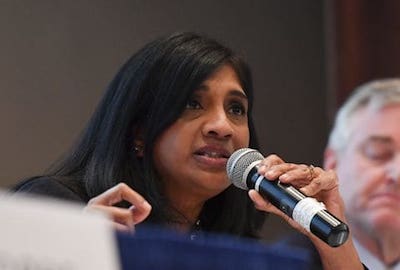
It may be accepted that waiting to restart all sectors of the economy simultaneously will unnecessarily keep some sectors shut that actually can be re-engineered to open without much further delay.
America should restart its economy and other operations by mitigating risk and making sure that it is done right to be able to succeed at the effort. While playing safe and delaying it beyond May 2020 may sound like the appropriate step to take, we should also know that it brings with it a loss of about two trillion dollars and a consequential setback worth several trillion dollars more every month. On the other hand, restarting America early may bring the risk of extending the misery due to COVID-19. There is no way to come to an optimized solution to this problem. It will have to be made by guts and appetite for risk-taking. We have to carefully look at several pro and con aspects and decide.
Restarting the economy would be especially important because some estimates tell us that the effect of coronavirus could hang on until August 2020 or even later. A shutdown of that magnitude no economy will be able to handle. Moreover, some say that coronavirus would come back with an even greater vengeance as cold season returns in the fall. The economy has to be ready to cope with that if it does indeed happen. In fact, the longer the U.S. economy remains in this dormant state, the longer it will need to get restarted, harder to bring it back to its past size and the greater irreparable harm it will cause.
To restart the economy, we will look at the type of operations deployed for product and service transformation. There are certain operations that are large, both in terms of the size of employment and contribution to the gross domestic product. This list includes businesses such as restaurant, retail, sports and entertainment, education and training, and travel and tourism that can be restarted with proper and careful reconfiguration, adaptation of technology, redesign and/or creative reinventing of their processes, workflows, and scheduling. Their restart can be begun in a matter of weeks.
We can formulate standards of operating for those large organizations that have more machine and technology interface and reduced human interactions. Such outfits include manufacturing, service processing, fulfillment centers, etc. The restart of these businesses will depend on how soon each of them comes up to these standards.
Taking the calculated risk of restarting this economy that had been willfully put to sleep rather than shut down because of an external one-time mishap will be unavoidable. It will have to be woken up with whims, such as presidential or gubernatorial executive orders . The alternative in the form of slower legislative processes will likely cause a long-lasting recession or depression or deep depression, as some are stating.
Moreover, no matter when we restart the economy, given the politically ultra-divided America and the anxiety over the upcoming presidential election, opposition to any proposal to restart is bound to be there. That is why, we have to move fast and devise a scheme to open the economy and begin the restarting in weeks rather than months. It may be accepted that waiting to restart all sectors of the economy simultaneously will unnecessarily keep some sectors shut that actually can be reengineered to open without much further delay.
Utilizing the countrywide state by state and county by county data on coronavirus already collected by the White House, we can sectorize our economy and get what can be started within weeks by presidential order and what will need congressional action. The latter will have to be started soon and completed on an expedited basis.
Operations that need longer will be restarted applying science, engineering and technology. Our effort should be to redesign human and machine interactions, human-to-human contacts, and group interfaces, all with the goal to mitigate the risk of any second or later legs of COVID-19. We should also work to adapt and design or redesign technologies, operations, and communication systems for keeping workers safe from all similar communicable diseases. This should also make the companies become even more productive.
America should use COVID-19 experience as a way to emphasize self-dependence for the production and distribution of all goods, services, processes, and technologies. This experience has taught us that all these are important and not just the essential ones.
We should also work to make sure that we bring back manufacturing to the USA and place requisite importance on research to help us achieve this self-dependence in an economically competitive way. The White House should continue to exert pressure to make sure that American business invests in the goal of self-dependence. Furthermore, we should make sure that our businesses set research and development intensity to achieve the goal.
We should also fight COVID-19 worldwide and help other countries restart their economies, replicating what we did to put the world back to work after the two world wars.
( A. D. Amar, Ph.D. is Professor of Management at the Stillman School of Business, Seton Hall University, South Orange, NJ 07079 (ad.amar@shu.edu). He was one of the three academics who endorsed Donald Trump for president in 2015, much before the primary elections of 2016. Later, he founded Indian-Americans for Trump 2016, a PAC, registered to promote Trump for president)






Spot on with this write-up, I truly think this website needs way more consideration. I’ll most likely be again to learn rather more, thanks for that info.
I’m truly enjoying the design and layout of your blog. It’s a very easy on the eyes which makes it much more enjoyable for me to come here and visit more often. Did you hire out a designer to create your theme? Excellent work!
I’ve been exploring for a little for any high quality articles or blog posts on this kind of area . Exploring in Yahoo I at last stumbled upon this website. Reading this info So i’m happy to convey that I have an incredibly good uncanny feeling I discovered just what I needed. I most certainly will make sure to do not forget this website and give it a glance regularly.
I like the efforts you have put in this, thank you for all the great blog posts.
Hello my friend! I wish to say that this post is awesome, nice written and come with approximately all important infos. I would like to peer extra posts like this.
My brother suggested I may like this website. He was totally right. This submit actually made my day. You can not believe simply how much time I had spent for this information! Thank you!
I appreciate, cause I found exactly what I was looking for. You have ended my four day long hunt! God Bless you man. Have a nice day. Bye
Hey there, I think your website might be having browser compatibility issues. When I look at your blog in Firefox, it looks fine but when opening in Internet Explorer, it has some overlapping. I just wanted to give you a quick heads up! Other then that, awesome blog!
This blog is definitely rather handy since I’m at the moment creating an internet floral website – although I am only starting out therefore it’s really fairly small, nothing like this site. Can link to a few of the posts here as they are quite. Thanks much. Zoey Olsen
I have read several just right stuff here. Certainly price bookmarking for revisiting. I surprise how so much attempt you set to create this type of fantastic informative web site.
You can definitely see your expertise in the work you write. The world hopes for even more passionate writers like you who aren’t afraid to say how they believe. Always follow your heart.
Of course, what a fantastic blog and educative posts, I surely will bookmark your site.Best Regards!
Howdy! This is my first visit to your blog! We are a team of volunteers and starting a new project in a community in the same niche. Your blog provided us beneficial information to work on. You have done a marvellous job!
I am continuously searching online for ideas that can benefit me. Thanks!
I’m extremely impressed with your writing abilities and also with the format for your weblog. Is this a paid subject or did you modify it yourself? Anyway keep up the excellent high quality writing, it’s uncommon to see a great blog like this one these days..
Wow! Thank you! I continuously needed to write on my website something like that. Can I take a portion of your post to my website?
Almost all of what you say happens to be supprisingly appropriate and it makes me ponder the reason why I hadn’t looked at this in this light before. This article really did turn the light on for me personally as far as this particular topic goes. However there is 1 position I am not really too cozy with so whilst I attempt to reconcile that with the main idea of the issue, permit me observe just what all the rest of your visitors have to say.Well done.
Aw, this was a very nice post. In idea I would like to put in writing like this moreover – taking time and precise effort to make an excellent article… but what can I say… I procrastinate alot and not at all seem to get something done.
Good website! I really love how it is easy on my eyes and the data are well written. I’m wondering how I could be notified when a new post has been made. I have subscribed to your RSS feed which must do the trick! Have a nice day!
Hey there! I know this is kinda off topic however , I’d figured I’d ask. Would you be interested in trading links or maybe guest writing a blog article or vice-versa? My site covers a lot of the same topics as yours and I think we could greatly benefit from each other. If you’re interested feel free to send me an e-mail. I look forward to hearing from you! Awesome blog by the way!
482029 945081Fantastic site you got here! Yoo man fantastic reads, post some much more! Im gon come back so far better have updated 693641
Great beat ! I wish to apprentice while you amend your website, how can i subscribe for a blog website? The account helped me a applicable deal. I have been tiny bit familiar of this your broadcast provided brilliant clear concept